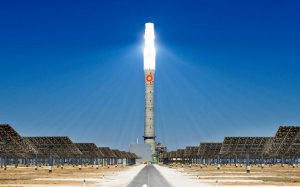ESTELA welcomes and supports the endeavour of the European Commission bringing together the Green Deal and the Recovery Plan. This initiative of the Commission constitutes a strong action framework impacting the depth and pace of the decarbonisation of the electricity, industry, and transport sectors. The European Solar Industry is ready to support it towards the deployment of innovative multi-technologies solutions, optimising investments and funding.
Concentrated Solar Thermal Technologies (CST) are an important part of the “European Solar Industry” which encompasses much more than the sole PV sector.
CST is a mature technology, immediately available to provide bulk storage capacities. It should therefore be part of the promoted sector integration – that indeed integrates the assets of all renewables and decreases the full system costs of a power system (instead of shifting them to peak hours after sunset). This is why CST are a decisive timely complement to an even wider deployment of intermittent technologies (especially PV, but also of wind) in- and outside Europe that could limit the expected shrink of the European solar market.
The tendering of 15 GW of renewable electricity will no doubt stimulate the market. Yet, it should be not only about new generation plants, but also about improving or revamping existing plants via addition or increase of thermal storage. This is especially true for Southern Europe where electricity systems will achieve bulk storage capacities at competitive costs1, avoiding fossil-fuel backup. But it is by no means limited to the South of Europe since night-time energy on demand can be exported to Northern Europe using the Cooperation Mechanisms already provided by the Commission or to be supported via the future EU Renewable Energy Financing Mechanism.

However, a main condition would be that the European Commission calls Member States to stop using LCOEs2 as the only metric for guiding their investment decisions. The assessment of the added value of flexibility delivered by the built-in storage in CST plants must be introduced in the tendering processes.
For the decarbonisation of industry, the Just Transition Fund (JTF) should state conditions which reward cost and investment optimisation. Thermal energy storage can be used directly in Central and Northern Europe to retrofit fossil-fired power plants. This avoids overinvestments and allows further use of existing generation and grid connection infrastructures.
Industrial processes can also be decarbonised through CST at costs below renewable fuels or electricity based options, providing and storing high temperature heat with a remarkably high capacity factor (7,000h/year). In this context, the use of “decarbonised gas” will also play an important role in harder-todecarbonise areas, in the mid/long term. CST can help scale-up green hydrogen, allowing an efficient carbon-free operation of its production at constant load and at high capacity factors –both factors of cost reduction.
The Green Deal must therefore offer an efficient financial support in which all non-intermittent renewables (concentrated solar, geothermal, …) have the possibility to fairly compete for eligibility. The revision of the TEN-E Regulation, new EU co-financed projects or dedicated funding for R&I initiatives must give space for these technologies. This will level the playing field between EU countries, and support the EU’s Neighbourhood Instrument policies within a more ambitious European innovation ecosystem.
ESTELA is looking forward to cooperating with you on these issues.
Best regards,
Jose-Luis MARTINEZ-DALMAU President of ESTELA


